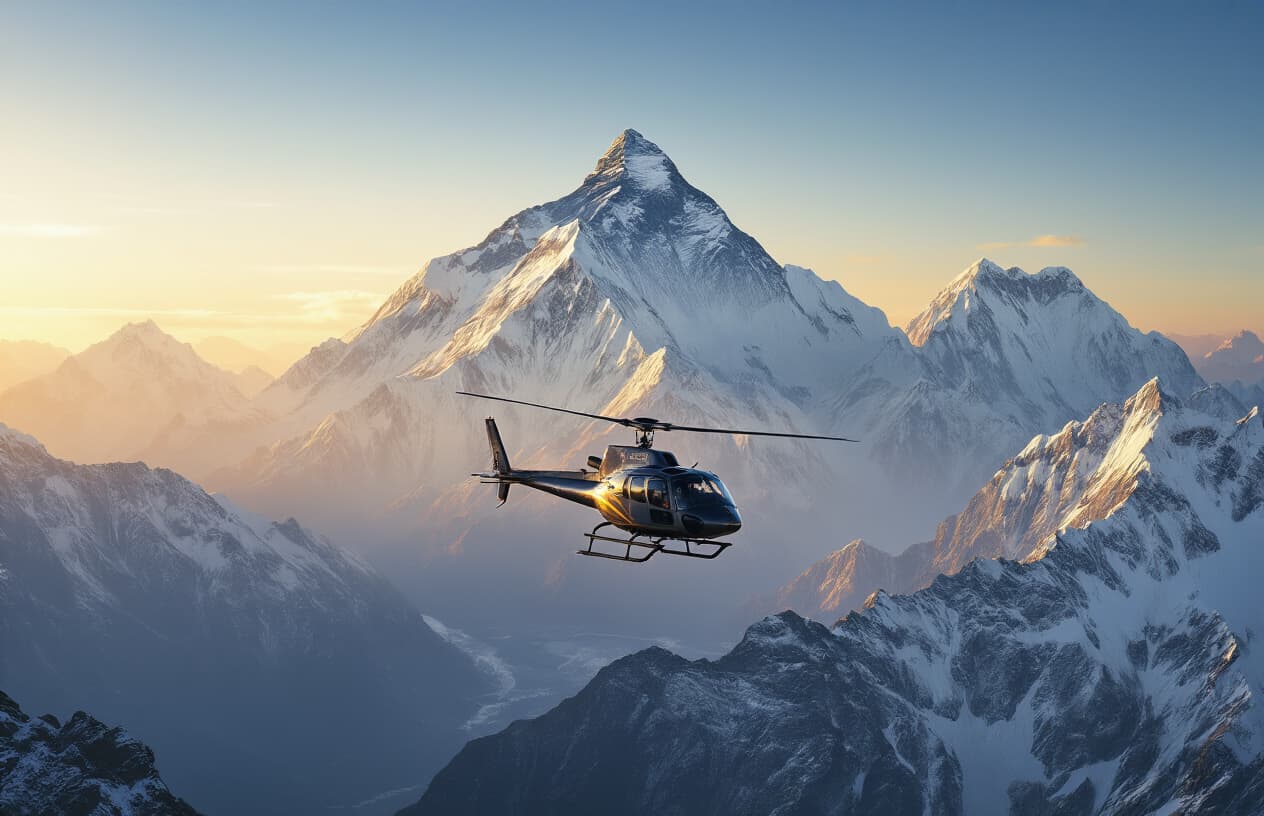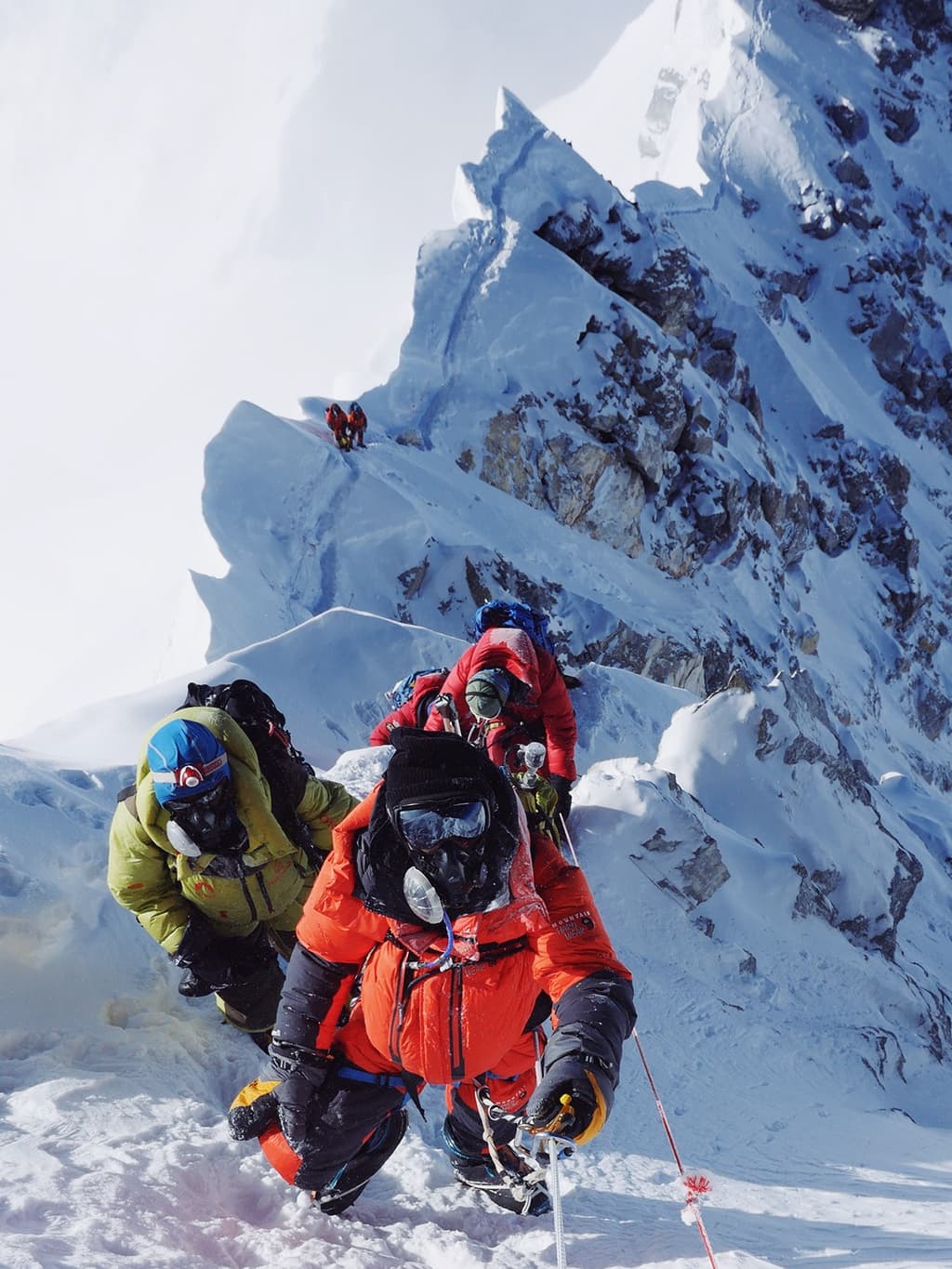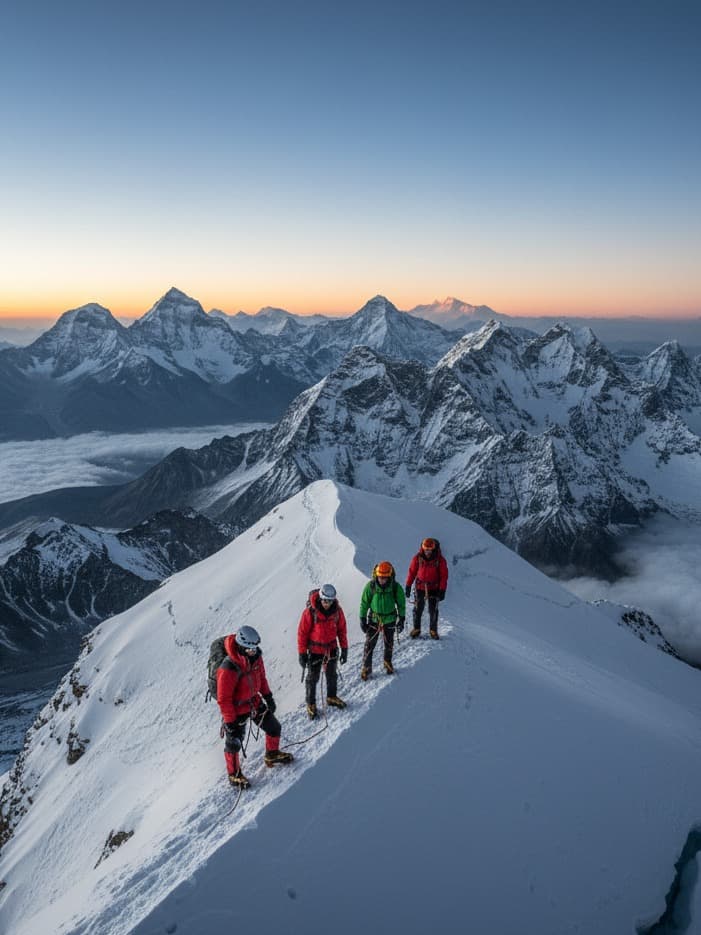Nepal's towering peaks and hidden valleys create some of the world's most breathtaking helicopter adventures. This guide helps thrill-seekers, luxury travelers, and mountain enthusiasts discover the best helicopter tours Nepal has to offer.
You'll learn about essential helicopter routes that take you face-to-face with Everest and the Annapurna range, giving you views most people only see in documentaries. We'll break down premium helicopter services and their safety standards so you can book with confidence. You'll also get insider tips on the best booking times for crystal-clear mountain views and smart ways to save money on these once-in-a-lifetime experiences.
From sunrise flights over the Himalayas to landing at Everest Base Camp, Nepal's helicopter tours offer adventures that can't be found anywhere else on Earth.
Essential Helicopter Routes That Showcase Nepal's Stunning Landscapes
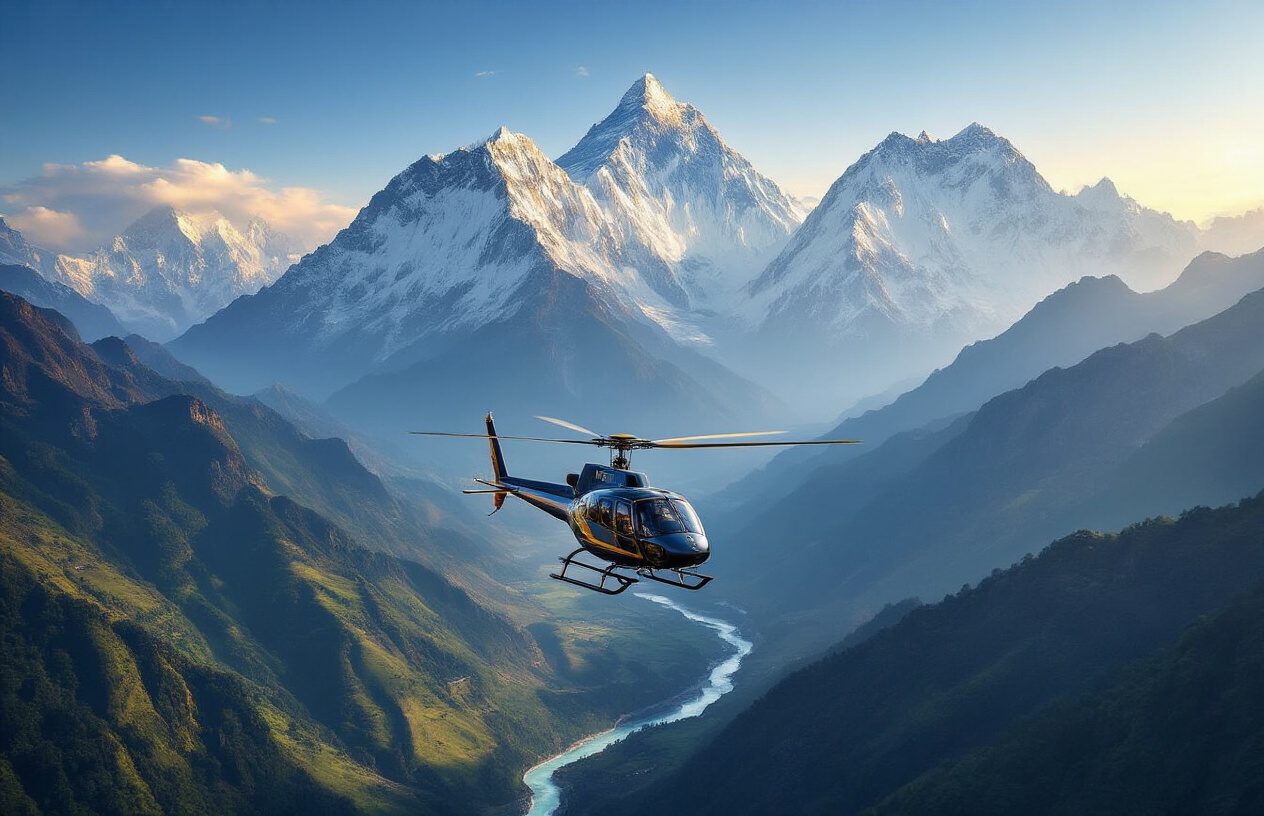
Everest Base Camp Helicopter Tour with Landing Experience
The crown jewel of Nepal's helicopter adventures takes you straight to the world's highest peak. This spectacular journey begins with a breathtaking flight over Kathmandu Valley, ascending through the dramatic landscapes of Sagarmatha National Park. You'll witness the legendary Sherpa villages of Namche Bazaar and Tengboche Monastery from above before reaching the iconic Everest Base Camp.
The landing experience at Kala Patthar (17,598 feet) offers unparalleled views of Mount Everest's north face. Standing at this altitude, you'll capture once-in-a-lifetime photographs with the world's tallest mountain as your backdrop. Most tours include a champagne breakfast at Hotel Everest View, perched dramatically at 13,000 feet with panoramic mountain vistas.
Key highlights include:
- Close-up views of Everest, Lhotse, Nuptse, and Ama Dablam
- Landing at Kala Patthar for ground-level mountain photography
- Flight duration of 4-5 hours with multiple scenic stops
- Professional mountain guides providing geological and cultural insights
Weather conditions play a crucial role in this adventure. Morning flights typically offer the clearest mountain views, while afternoon clouds can obscure the peaks. The entire experience combines raw natural beauty with luxury comfort, making it accessible to adventurers who want Everest views without the weeks-long trek.
Annapurna Circuit Scenic Flight with Mountain Views
The Annapurna region helicopter tour showcases Nepal's most diverse mountain landscapes in a single flight. This route takes you through the heart of the Annapurna Conservation Area, revealing the dramatic contrasts between lush subtropical valleys and towering snow-capped peaks reaching over 26,000 feet.
Your aerial journey begins with views of the Modi Khola river valley, winding through terraced hillsides and traditional Gurung villages. The helicopter ascends toward Annapurna Base Camp, offering spectacular perspectives of the Annapurna Massif, including Annapurna I, Machapuchare (Fishtail), and Hiunchuli.
The flight path typically includes landing opportunities at Annapurna Base Camp or nearby helicopter pads, allowing passengers to step onto glacier moraines surrounded by some of the world's most dramatic mountain amphitheaters. The contrast between the tropical valleys below and the arctic conditions at altitude creates an incredible sensory experience.
Flight highlights:
- 360-degree mountain panoramas from multiple vantage points
- Traditional mountain village flyovers
- Glacier landings with professional photo opportunities
- Duration ranges from 2-4 hours, depending on weather conditions
This route works particularly well for photography enthusiasts, as the varied terrain provides diverse shooting opportunities within a single flight. The Annapurna helicopter tour offers excellent value, combining accessibility with some of Nepal's most photogenic mountain scenery.
Langtang Valley Helicopter Adventure
Langtang Valley represents Nepal's hidden gem for helicopter enthusiasts seeking pristine mountain wilderness without extreme altitudes. Located just north of Kathmandu, this valley offers dramatic alpine scenery, ancient Tibetan Buddhist culture, and relatively stable weather conditions throughout most of the year.
The helicopter route follows the Langtang River valley, carved deep between towering ridges that rise dramatically from 4,000 feet to over 23,000 feet. You'll fly over traditional Tamang villages, ancient monasteries, and yak pastures while approaching the Langtang Lirung glacier system. The valley's unique geography creates a natural amphitheater of peaks, including Langtang Lirung (23,771 feet), Gang Chhenpo, and Dorje Lakpa.
Landing opportunities include Kyanjin Gompa (12,500 feet), where you can explore Tibet's oldest cheese factory and interact with local Tamang communities. The helicopter can also access remote glacier landing sites for premium mountain experiences away from trekking crowds.
Adventure features:
- Cultural interactions with the Tamang and Sherpa communities
- Cheese factory visits at traditional high-altitude settlements
- Glacier walking opportunities with professional guides
- Wildlife spotting, including Himalayan tahr and red pandas
- Flight time of 3-4 hours with cultural stops
Langtang Valley helicopter tours excel in combining natural beauty with cultural authenticity. The region's recovery from the 2015 earthquake has created new opportunities for responsible tourism that directly benefit local communities.
Manaslu Region Aerial Exploration
The Manaslu region helicopter tour ventures into one of Nepal's most remote and spectacular mountain areas, centered around the world's eighth-highest peak at 26,781 feet. This route offers exclusive access to pristine valleys and ancient Tibetan culture that few travelers ever experience.
Your flight path crosses the dramatic Buri Gandaki valley, revealing traditional stone villages, ancient Buddhist monasteries, and terraced barley fields that have remained unchanged for centuries. The helicopter approaches Manaslu's massive south face, providing perspectives of the mountain's technical climbing routes and massive avalanche zones that make ground-based access extremely challenging.
Landing sites include Samagaon village (11,500 feet), where you can explore traditional Tibetan architecture and interact with local Nubri people. Advanced helicopter tours can access glacier landing zones near Manaslu Base Camp, offering close encounters with active icefalls and crevasse systems.
Exploration highlights:
- Exclusive access to restricted area permits normally requiring weeks of trekking
- Traditional Tibetan Buddhist monastery visits
- Glacier photography with minimal tourist presence
- Cultural exchanges with Nubri and Gurung communities
- Flight duration of 4-6 hours including cultural stops
The Manaslu helicopter experience represents adventure travel at its most exclusive. Limited helicopter operators have access permits for this region, making advance booking essential. Weather windows are more restrictive than other routes, but successful flights reward passengers with unparalleled mountain wilderness experiences.
Premium Helicopter Services and Safety Standards You Can Trust
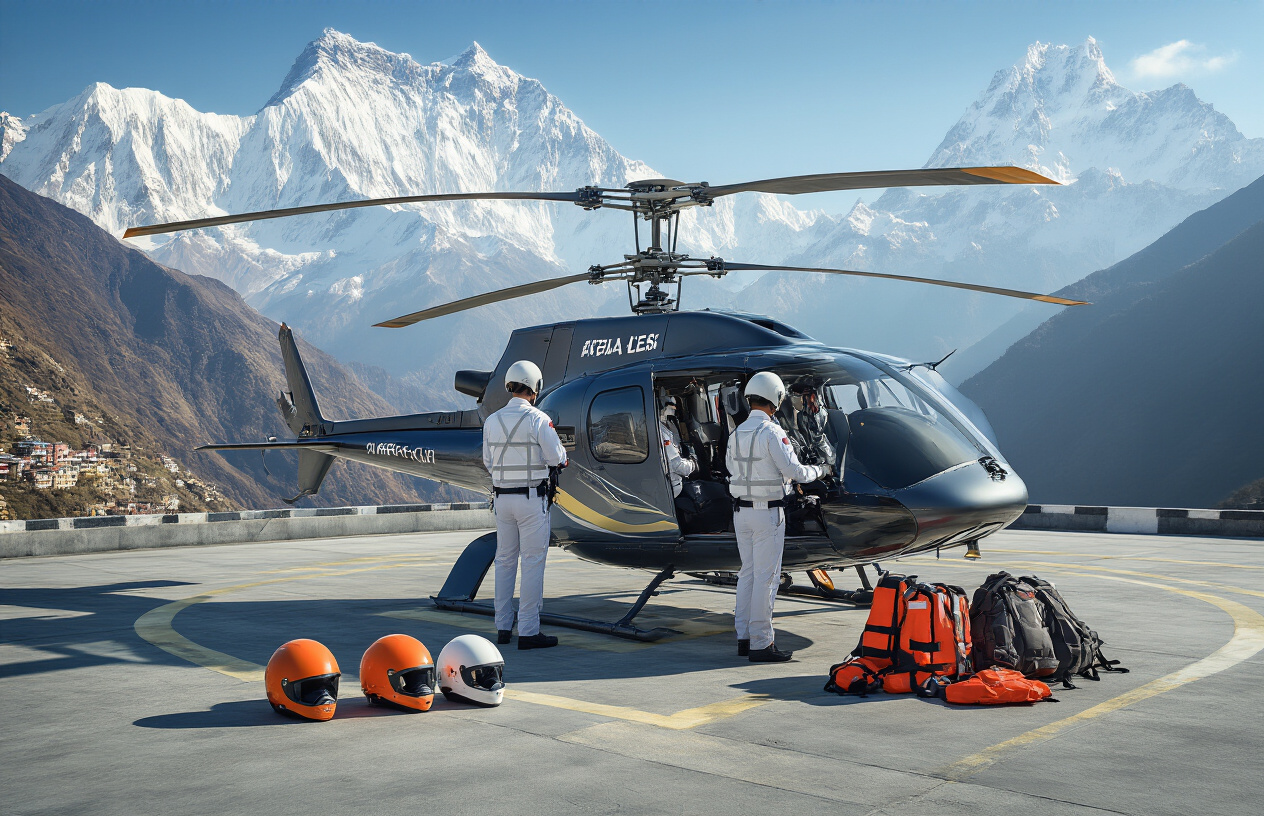
Licensed Operators with International Safety Certifications
When choosing a helicopter service in Nepal, you want operators who meet the highest international standards. The best companies hold certifications from organizations like the International Civil Aviation Organization (ICAO) and follow strict guidelines set by Nepal's Civil Aviation Authority. These certifications aren't just paperwork - they represent rigorous safety protocols, regular audits, and proven track records.
Top-tier operators typically display their credentials prominently and can provide documentation of their safety ratings. Look for companies that have partnerships with international aviation authorities or maintain memberships in global helicopter associations. These operators invest heavily in training programs and safety equipment that go beyond local requirements.
Many reputable helicopter services in Nepal also carry international insurance coverage, which protects both the company and passengers in case of incidents. This insurance often requires meeting even stricter safety standards than local regulations demand.
Modern Fleet Maintenance and Pilot Experience Requirements
The aircraft you fly in should be modern, well-maintained, and specifically designed for high-altitude operations. Nepal's mountainous terrain and unpredictable weather patterns demand helicopters that can handle extreme conditions. Leading operators use aircraft like the Airbus AS350 B3e or Bell 407, which are engineered for high-altitude performance and have excellent safety records in mountain environments.
Maintenance schedules for these aircraft are incredibly strict. Premium operators follow manufacturer recommendations down to the hour, often exceeding required maintenance intervals. They maintain detailed logbooks and use certified technicians who specialize in high-altitude helicopter maintenance.
Pilot qualifications make all the difference in mountain flying. The best operators require their pilots to have:
- Minimum 2,000+ flight hours total experience
- At least 500 hours specifically in Nepal's mountain regions
- Current instrument rating and mountain flying certification
- Regular recurrent training every six months
- Emergency procedure training specific to high-altitude conditions
Many top pilots have backgrounds in rescue operations or military aviation, bringing additional expertise to challenging flying conditions.
Weather Monitoring Systems and Flight Cancellation Policies
Mountain weather changes rapidly, and professional operators use sophisticated monitoring systems to track conditions in real-time. The best companies have weather stations at multiple locations and maintain direct communication with meteorological services throughout the flight region.
Advanced operators use satellite weather data, wind measurement tools, and visibility monitoring equipment. They also have established relationships with ground personnel at various landing sites who provide real-time weather updates from remote locations.
Flight cancellation policies vary, but reputable operators prioritize safety over profits. Most offer:
- Same-day cancellations with full refunds for weather-related issues
- Flexible rescheduling options without penalty fees
- Partial flight completion refunds if weather forces early return
- Alternative route options when primary destinations become inaccessible
The best companies will cancel flights even when conditions are technically flyable if they're not optimal for passenger comfort and safety. They understand that disappointed customers are better than endangered ones.
Quality operators also provide clear communication about weather delays, offering regular updates and realistic timeframes for potential departure windows. They'll work with you to adjust itineraries and may suggest backup plans when weather patterns look unfavorable for extended periods.
Best Times to Book Your Helicopter Adventure for Optimal Views
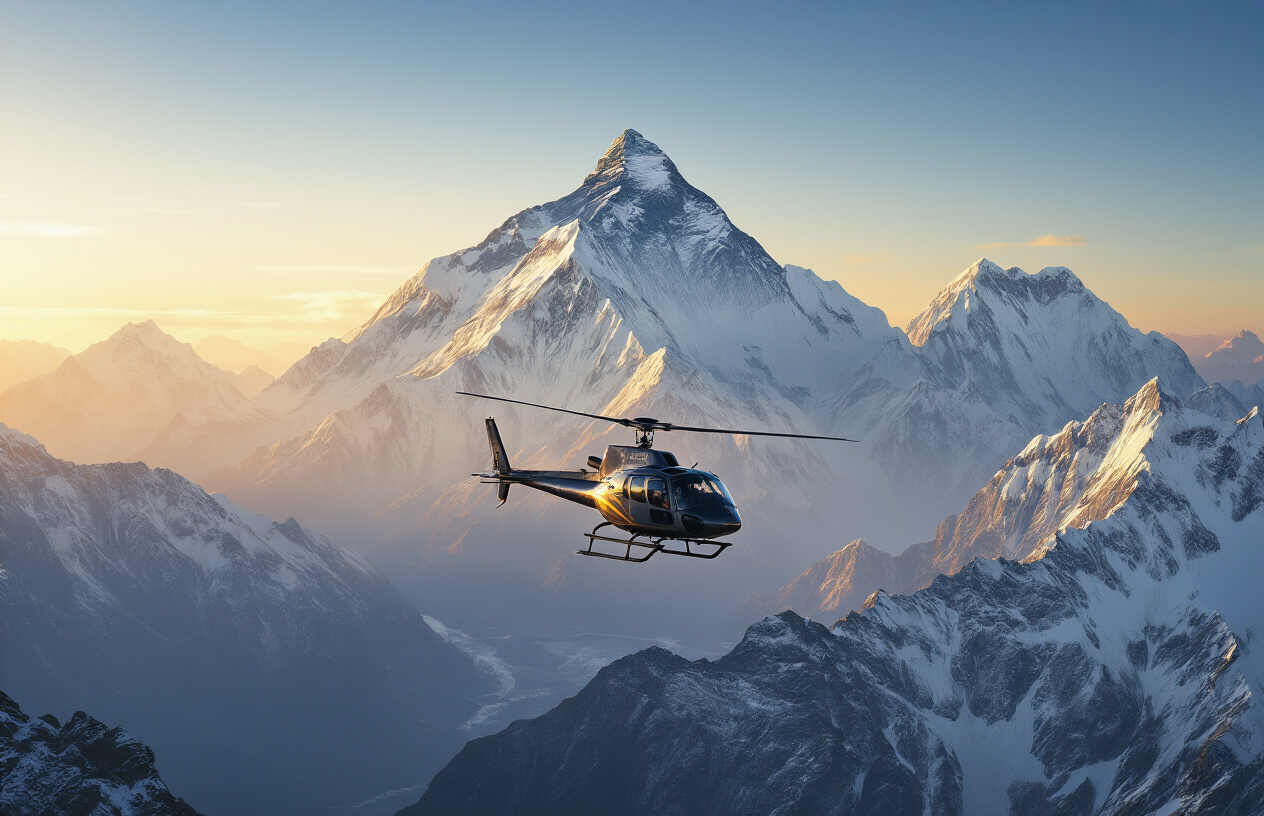
Peak Season Benefits During October to December
The months from October to December represent the golden window for helicopter adventures in Nepal. Crystal-clear skies dominate this period, offering photographers and adventurers the clearest mountain vistas of the entire year. The monsoon rains have washed the air clean, creating exceptional visibility that can extend for hundreds of miles on perfect days.
Weather patterns during these months are remarkably stable, with minimal cloud cover and virtually no precipitation. Morning flights particularly shine during this season, as the atmosphere remains calm before thermal activity picks up later in the day. Mountain peaks stand out in sharp relief against deep
blue skies, making every photograph look like a professional shot.
The downside? Everyone knows about these perfect conditions. Helicopter services experience peak demand, which translates to higher prices and limited availability. Booking at least 2-3 months in advance becomes essential, especially for popular destinations like Everest Base Camp or Annapurna Circuit overflights.
Temperature-wise, the weather stays comfortable at lower elevations while remaining crisp but manageable at higher altitudes. You'll want to pack layers, but the conditions rarely become harsh enough to cancel flights due to weather.
Spring Season Advantages from March to May
Spring brings its own magic to Nepal's helicopter scene. The pre-monsoon period offers excellent flying conditions with generally clear mornings and stunning mountain visibility. Rhododendrons bloom across the hillsides during this time, painting the landscape in vibrant reds and pinks that create breathtaking contrasts against snow-capped peaks.
March typically provides the most stable weather within this season, with April following close behind. May can get trickier as afternoon thunderstorms become more frequent, making morning departures the smart choice. The advantage here lies in slightly lower prices compared to peak season, though costs remain elevated due to good weather conditions.
Wildlife viewing reaches its peak during the spring months. Helicopter tours to places like Chitwan National Park or remote valleys offer excellent chances to spot animals as they become more active after winter. The moderate temperatures make multi-stop itineraries more comfortable for passengers.
One thing to watch out for: haze can build up during late spring, particularly in the afternoons. This atmospheric condition reduces photographic opportunities and overall visibility, making early morning flights your best bet for spectacular views.
Monsoon Season Considerations and Limited Operations
The monsoon period from June through September presents significant challenges for helicopter operations in Nepal. Heavy rainfall, thick cloud cover, and unpredictable weather patterns force many operators to severely limit their services or suspend them entirely during peak monsoon weeks.
However, the monsoon doesn't mean a complete shutdown. Many helicopter companies maintain limited operations, focusing on essential services and taking advantage of occasional clear weather windows. These brief opportunities can actually provide some of the most dramatic flying experiences, with waterfalls cascading down mountainsides and lush green valleys that look completely transformed from their dry-season appearance.
Safety becomes the primary concern during this period. Reputable operators maintain strict weather monitoring protocols and won't compromise passenger safety for any booking. Flight cancellations become common, so travelers need flexible schedules and realistic expectations.
The few tourists who do manage successful monsoon helicopter flights often report incredibly rewarding experiences. The landscapes appear more vibrant and alive, with terraced fields glowing bright green and rivers running full. Prices during this season hit their lowest points, making it attractive for budget-conscious adventurers willing to gamble on weather conditions.
Smart monsoon travelers keep backup plans ready and avoid tight connection schedules, as weather delays can extend for several days without warning.
Planning Your Perfect Helicopter Adventure Itinerary
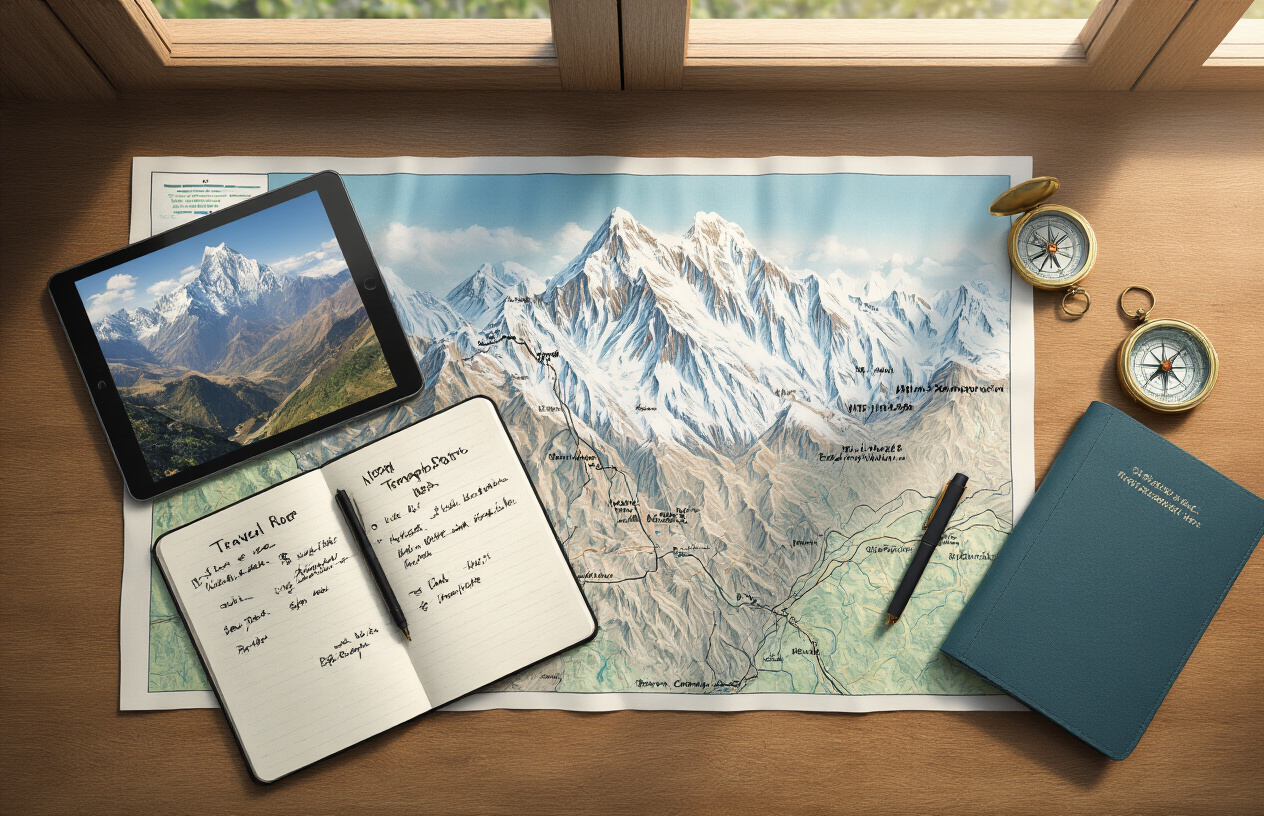
Physical Fitness Requirements and Health Considerations
High-altitude helicopter flights in Nepal demand more from your body than typical tourist activities. At elevations reaching 18,000 feet or higher, oxygen levels drop significantly, and even healthy individuals can experience altitude-related symptoms. You don't need to be an Olympic athlete, but basic cardiovascular fitness makes the experience far more enjoyable.
Most helicopter tours require passengers to complete a health questionnaire. Pre-existing heart conditions, respiratory issues, or blood pressure problems need medical clearance before booking. Pregnant women face restrictions on flights above certain altitudes, typically 12,000 feet.
Age restrictions vary by operator, but most accept passengers from 3 to 75 years old. Children under 12 often qualify for discounted rates, though they must occupy their own seat for safety reasons. Weight limits per passenger range from 220-265 pounds, depending on the helicopter model and total passenger load.
Prepare your body by staying hydrated in the days leading up to your flight. Alcohol consumption 24 hours before departure can worsen altitude effects. Pack motion sickness medication even if you don't typically experience it – mountain thermals create different flight patterns than commercial aviation.
The rapid altitude changes during Everest Base Camp flights can trigger headaches or nausea. Operators provide oxygen if needed, but inform your pilot immediately if you feel unwell. Most symptoms subside quickly once you descend to lower elevations.
Essential Gear and Camera Equipment for Aerial Photography
Helicopter windows create unique photography challenges that standard tourist gear can't handle. Vibration, glare, and rapid scene changes require specific equipment choices and techniques to capture Nepal's dramatic landscapes effectively.
Bring a camera with fast autofocus and high ISO performance. Mirrorless cameras work exceptionally well due to their lighter weight and silent shooting modes. DSLRs remain excellent choices, but consider the additional bulk when packing other essentials.
Recommended Camera Settings:
- Shutter speed: 1/500s minimum to eliminate vibration blur
- ISO: 400-1600 for optimal image quality
- Aperture: f/8-f/11 for maximum landscape sharpness
- Focus: Single-point autofocus on infinity or hyperfocal distance
Polarizing filters dramatically improve image quality by reducing window glare and enhancing sky contrast. Circular polarizers work best with autofocus systems. UV filters protect your lens while minimizing atmospheric haze at high altitudes.
Pack extra batteries and memory cards – cold temperatures drain power faster, and you'll capture far more images than anticipated. A small cleaning cloth removes condensation from lenses when transitioning between altitudes.
Wide-angle lenses (14-24mm) capture expansive mountain vistas, while 70-200mm telephoto lenses isolate specific peaks or glacial details. Avoid changing lenses during flight – dust and vibration create unnecessary risks.
Smartphone cameras perform surprisingly well for social media content. Use airplane mode to conserve battery while keeping the camera function active. Third-party camera apps often provide better manual controls than default applications.
Accommodation Booking Tips Near Helicopter Departure Points
Strategic accommodation choices significantly impact your helicopter adventure experience. Most flights depart from Kathmandu's Tribhuvan International Airport or dedicated heliports in Lukla and Pokhara. Each location offers distinct advantages and booking considerations.
Kathmandu Area Options:
- Airport hotels provide 5-10 minute transfers, but limited local atmosphere
- Thamel district offers cultural immersion with 20-30 minute airport access
- Luxury properties in Durbur Marg blend convenience with premium amenities
Book accommodations within 30 minutes of your departure point. Morning flights often require 5:00 AM departures, making nearby lodging essential. Traffic congestion in Kathmandu can double travel times during peak hours.
Lukla-based helicopter tours serve trekkers continuing overland adventures. Tea houses and lodges provide basic accommodations, but reservations remain crucial during peak seasons (March- May, September-November). Altitude adjustment becomes important at Lukla's 9,334-foot elevation.
Pokhara departures offer the widest accommodation range, from budget guesthouses to five-star resorts overlooking Phewa Lake. The city's lower altitude (2,700 feet) eliminates acclimatization concerns while providing stunning Annapurna views from your hotel room.
Booking Timeline:
- Peak season: Reserve 2-3 months ahead
- Shoulder season: 4-6 weeks booking
- Off-season: 2-3 weeks sufficient
Confirm your accommodation provides airport transfers or reliable taxi arrangements. Many hotels offer complimentary shuttle services for helicopter tour participants when arranged during booking.
Travel Insurance Coverage for High-Altitude Helicopter Flights
Standard travel insurance policies often exclude high-altitude activities, leaving helicopter passengers financially exposed during Nepal's mountain flights. Specialized coverage protects against unique risks associated with aerial adventures above 15,000 feet.
High-altitude helicopter rescue represents the most critical coverage gap. Emergency evacuations from remote mountain locations can cost $15,000-$50,000, depending on weather conditions and helicopter availability. Standard policies typically cap helicopter rescue benefits at $1,000-$5,000.
Essential Coverage Components:
- High-altitude activities up to 20,000+ feet
- Helicopter rescue and evacuation services
- Trip cancellation due to weather conditions
- Medical coverage for altitude-related illnesses
- Equipment coverage for cameras and personal items
Adventure travel insurance providers like World Nomads, IMG, or Allianz offer comprehensive high-altitude coverage. Annual policies often cost less than trip-specific coverage for frequent travelers. Read policy exclusions carefully – some insurers limit coverage based on pilot licensing or aircraft certification.
Weather-related cancellations occur frequently in Nepal's mountain regions. Comprehensive trip interruption coverage reimburses non-refundable helicopter deposits and additional accommodation costs during extended delays. Standard coverage typically provides 100-150% of trip costs.
Medical evacuation insurance becomes particularly important for travelers with pre-existing conditions. Altitude can exacerbate underlying health issues, requiring immediate descent and medical attention. Ensure your policy covers pre-existing conditions with proper disclosure and waiting periods.
Purchase insurance within 14 days of your initial trip deposit to maximize coverage benefits. Many policies include "cancel for any reason" riders when purchased early, providing additional flexibility for changing travel plans.
Unique Add-On Experiences That Enhance Your Helicopter Journey
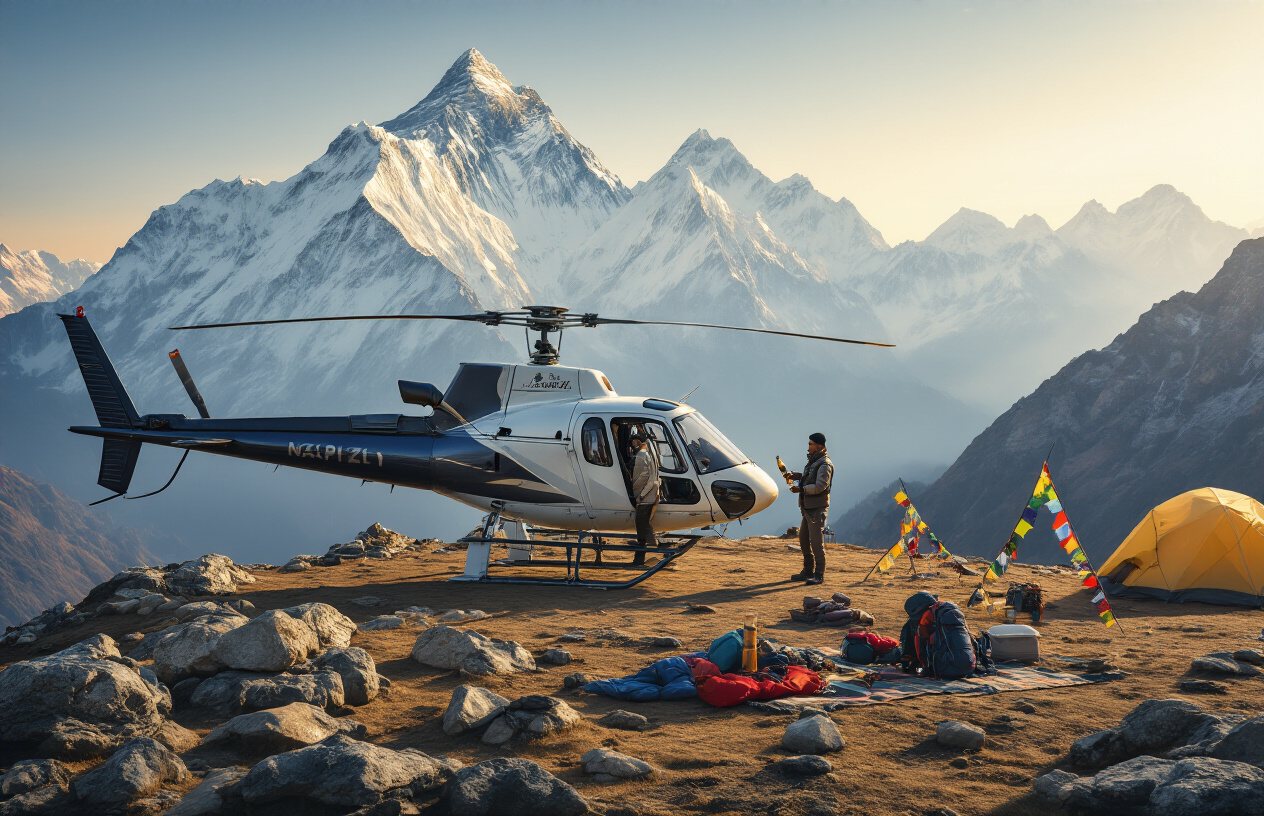
High-Altitude Landing Breakfast at Everest View Hotel
Picture yourself sipping hot coffee while the world's tallest peaks tower majestically before you. The Everest View Hotel experience stands as one of Nepal's most exclusive helicopter adventures, placing you at 12,779 feet above sea level for an unforgettable breakfast with a view.
Your helicopter lands directly at the hotel's helipad, where panoramic views of Everest, Lhotse, Nuptse, and Ama Dablam create a breathtaking backdrop. The hotel serves traditional Nepali breakfast alongside continental options, all while you're surrounded by some of the planet's most dramatic mountain scenery.
Weather conditions play a crucial role in this experience. Morning flights between October and December offer the clearest visibility, though spring months from March to May also provide excellent viewing opportunities. The helicopter typically stays for 45-60 minutes, giving you ample time to capture photos and absorb the incredible atmosphere.
Advanced booking becomes essential during peak seasons, as landing slots at this elevation require careful coordination with weather patterns. Most operators include this breakfast stop as part of extended Everest region tours, combining it with additional scenic flights through the Khumbu Valley.
Monastery Visits and Cultural Immersion Stops
Remote monasteries scattered throughout Nepal's mountain regions offer helicopter passengers unique windows into centuries-old Buddhist traditions. These cultural stops transform your aerial adventure into a meaningful spiritual journey.
Tengboche Monastery in the Everest region ranks among the most popular helicopter destinations, serving as the spiritual heart of Sherpa culture. The ancient gompa sits at 12,664 feet, surrounded by rhododendron forests and commanding views of Everest's north face. Monks welcome visitors for brief ceremonies, sharing insights about their daily practices and the monastery's 600-year history.
The Muktinath Temple complex presents another compelling cultural stop, sacred to both Hindus and Buddhists. Your helicopter lands near this revered pilgrimage site, where 108 water spouts and an eternal flame create a mystical atmosphere. Local guides explain the temple's significance while you explore the prayer wheels and colorful prayer flags that decorate the compound.
Seasonal festivals add an extra dimension to monastery visits. During Mani Rimdu celebrations in autumn, Tengboche comes alive with masked dances and traditional ceremonies. Timing your helicopter tour with these events requires planning but rewards you with authentic cultural experiences rarely accessible to ground-based travelers.
Most cultural stops last 30-45 minutes, providing sufficient time for photography, brief meditation, and interaction with local communities while respecting their sacred spaces and traditions.
Wildlife Spotting Opportunities in Remote Valleys
Nepal's helicopter routes pass over pristine wilderness areas where rare wildlife thrives in landscapes inaccessible by foot. These aerial safaris combine adventure with exceptional opportunities to spot endangered species in their natural habitats.
The Langtang Valley offers remarkable chances to observe red pandas, Himalayan black bears, and various bird species from above. Early morning flights increase wildlife visibility, as animals venture into open areas before retreating to forest cover. Your pilot can hover at safe distances, allowing clear photography of grazing yaks, blue sheep, and occasional snow leopards on rocky outcrops.
Remote valleys near Manaslu and Annapurna regions harbor diverse ecosystems where golden eagles soar alongside helicopters, and herds of bharal (blue sheep) dot steep mountainsides. The helicopter's vantage point reveals animal movements and behaviors impossible to witness from ground level.
Experienced pilots familiar with wildlife patterns know optimal times and locations for sightings. Spring months bring animals to lower elevations as snow melts, while autumn offers clear visibility for spotting wildlife against golden grasslands. Many operators equip helicopters with high-powered binoculars and provide wildlife identification guides.
Conservation areas like Sagarmatha National Park and Annapurna Conservation Area restrict helicopter operations to protect sensitive habitats, but designated flight corridors still offer excellent wildlife viewing opportunities while maintaining minimal environmental impact on these precious ecosystems.
Conclusion
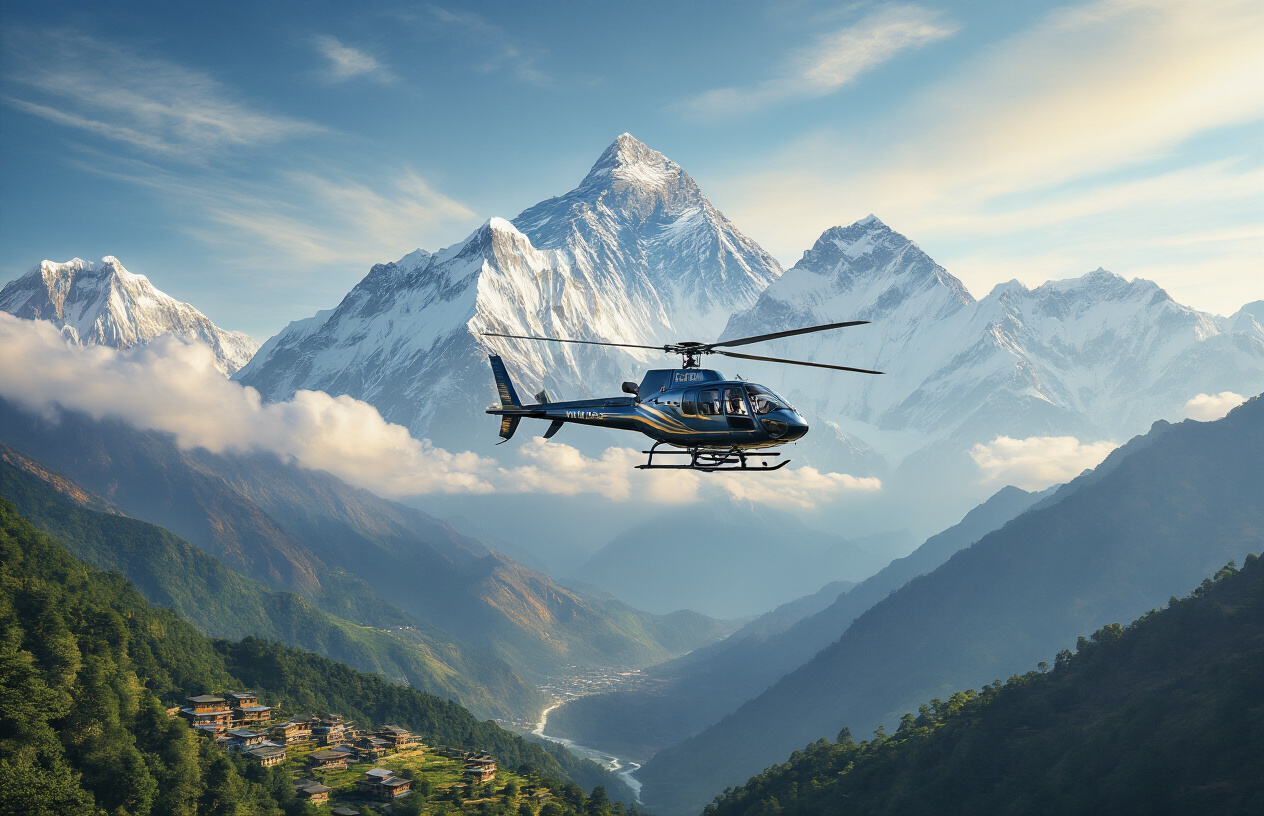
Nepal's helicopter adventures offer some of the most breathtaking aerial experiences on the planet, from soaring over the majestic Himalayas to landing at remote mountain villages. The key routes like Everest Base Camp, Annapurna Circuit, and Langtang Valley provide unmatched views of snow-capped peaks and diverse landscapes. Choosing reputable operators with strong safety records and modern fleets ensures your journey is both thrilling and secure, while booking during clear seasons like autumn and spring maximizes your chances of perfect visibility.
Smart planning can make your helicopter adventure both memorable and affordable. Book during shoulder seasons, compare packages from different operators, and consider group bookings to reduce costs significantly. Adding unique experiences like mountain landings, monastery visits, or luxury mountain lodge stays transforms a simple flight into an unforgettable adventure. Start planning your Nepal helicopter journey today – the Himalayas are waiting to show you their most spectacular secrets from above.
If you need any further information, please contact us by email: [email protected], Phone: +977- 980 195 6248 (WhatsApp).
